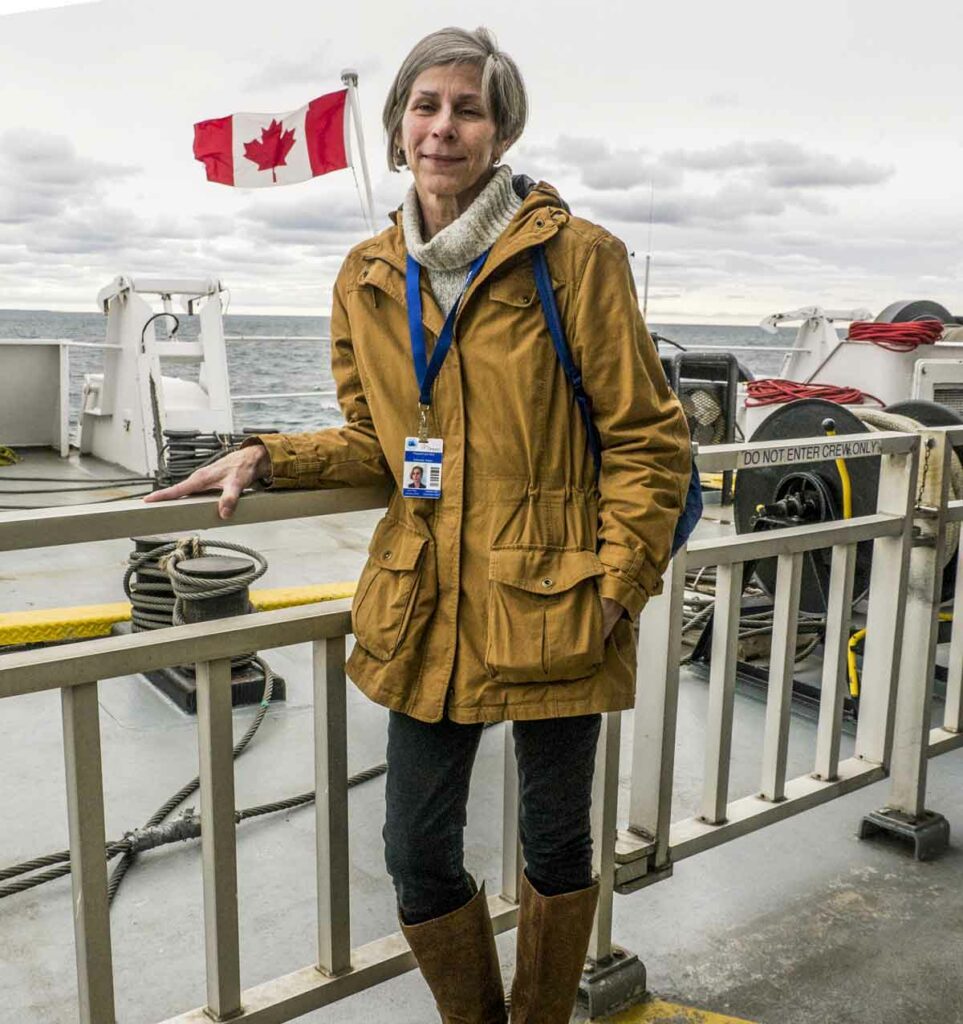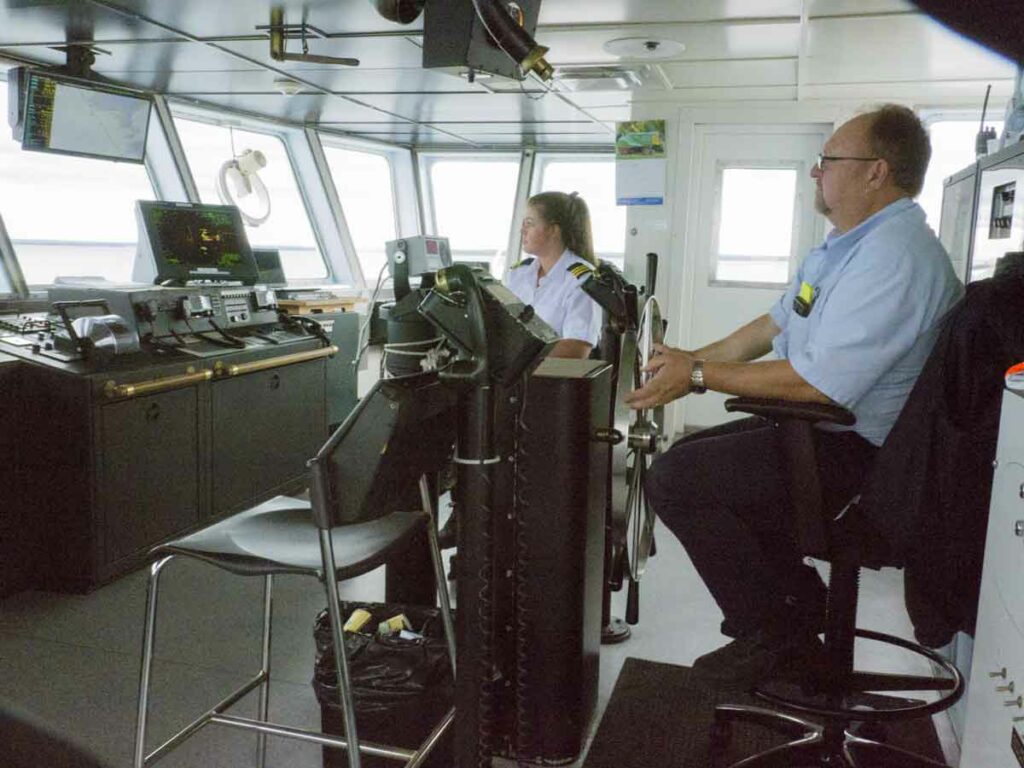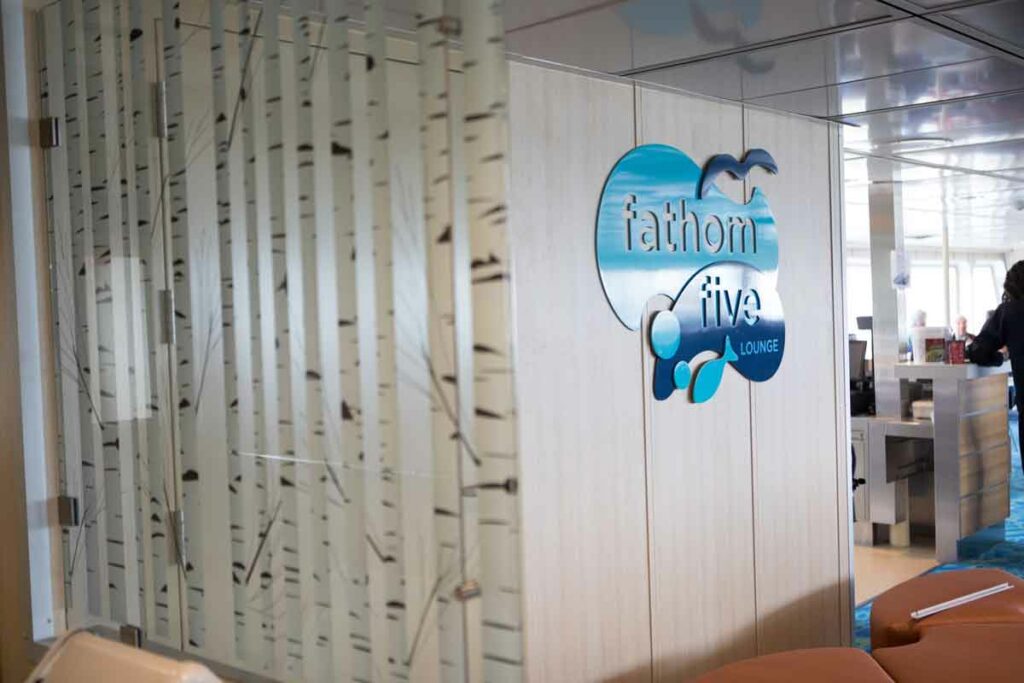By Isobel Harry, This Is Manitoulin April 2020
Boarding the Chi-Cheemaun in Tobermory or South Baymouth always signals an adventure. Casting off our attachments to terra firma, we gaze to the boundless horizon as we float majestically for almost two hours on the inland sea known as Georgian Bay, part of mighty Lake Huron, in a primordial panorama unchanged for millennia.
Now in its 45th year of service, owned by the Owen Sound Transportation Company (OSTC), the ‘Big Canoe’ has been announcing its arrivals and departures with those familiar horn blasts for almost five decades. The ferry serves as the seasonal second means of transportation off or on to Manitoulin Island, a vital link for residents and visitors, offering closer access to points in southern Ontario and the US. In winter, the Swing Bridge in Little Current becomes the only way to enter or exit the Island – both methods add more than a little ‘magical mystery tour’ to the journey.
The MS Chi-Cheemaun began her rule of the waves in the fall of 1974, built by Collingwood Shipbuilding at a cost of $10 million, a state-of-the-art ferry capable of transporting 638 passengers and crew and close to 150 vehicles with a crossing time of less than two hours. She ended that season as her “shakedown” period before going into full service in 1975.

Ten years later, at the precocious age of 23, Susan Schrempf, now CEO, was hired by the OSTC – one of Ontario’s largest ferry operators of passenger, vehicle and cargo transportation services on northern and southwestern Ontario waterways. First in purchasing, followed by stints in budgeting, labour relations and business planning. That was back in December, 1983, when, Ms. Schrempf recalls, “I did not know what the Chi-Cheemaun was. I first saw the ferry when I started in January, 1984.” By 1996, “learning on the job,” Ms. Schrempf had won the general manager’s position.
The buck always lands on the CEO’s desk. Today may be desk-free as we chat in the ferry’s redesigned dining lounge but Ms. Schrempf’s obvious passion for her profession is never far from her thoughts. She seems to know every crew member – their quarters are underneath the car deck, by the way – and nut, bolt and operation of the ferry.
In her 35 years with the OSTC, there’s been a lot of water under the big ship’s hull, and the experience and knowledge accumulated during a long career means Ms. Schrempf is on intimate terms with all the mitigating factors of sailing the Chi-Cheemaun – the weather, the huge machinery, the rules and regulations, the safety of all aboard. “Nothing’s ever the same every day” is her operating mantra. The watch system ensures there is always an engineer on board, directed by the chief engineer; four engines (only two are used for crossings) ensure that two can act as ‘spares’ – the ship is its own mechanical back-up. There are safety management systems and a reporting ladder and everything looks trim and neat, the very definition of ship-shape. “The ship is never on autopilot,” adds Ms. Schrempf, oddly comforting in this age of VR and AI and what-not running things as we climb up enclosed stairways and down narrow passages to the pilothouse for proof.
At the wheel, behind a curving wall of cantilevered windows giving onto a commanding view over the lake, sits Able Bodied Seaman Blaire Leeson, a Manitouliner by birth, with Chief Mate Kelsey Wade standing nearby, their eyes rarely wavering from the watery expanse ahead. You’d half expect a whale to breach in this infinite vastness, but no, neither has ever encountered anything unusual out these windows, although you can see how the Ojibwe legends of the underwater monster Mishebishu got started out here in the deeps.

The Chi-Cheemaun was re-engined in 2007, good for another 15 to 20 years, says the CEO. “This is a very solid design with high-quality construction. It would cost close to a hundred million dollars to replace this ferry.” Maintenance is carried out at night, vibration analysis and non-invasive infra red tests; in winter, inspections and more maintenance take place in Owen Sound (sometimes the ship is hired out as a movie set) and every five years the boat goes into dry dock for intensive checks. “The ship is extremely healthy,” says Ms. Schrempf, “It operates in fine weather and fresh water, reducing wear and tear, for six months of the year, including the 13 weeks of high season. Structurally, there’s no degradation – we saw that when the machinery was replaced and we did a complete ultrasound of the hull and, more recently, the rehab of the interior.”
The interior rehab took place “in response to passengers’ desires since the ‘90s not just for a ferry ride, but for an experience,” says Ms. Schrempf. Experiences came on board (along with the wrapping of the exterior in Anishinaabe-inspired graphics) and a new marketing brand -‘Travel in Good Spirits’ – from sunset dinner cruises to stargazing evenings with the Royal Astronomical Society, to concerts on Sundays and Indigenous stories and drumming workshops – and are now an embedded feature in high season sailings. “The entertainment and the experiences are all-Canadian,” she says, a fact that carries through to the ‘Boatique’ gift shop with its Canadian-made gift socks, hats, outerwear and books selection. The chief overseer is delighted to hear that most of the well-chosen merchandise – the season is ending soon at this writing –is almost all sold out.
With things ticking along so well on the Cheech (as she is known locally), what’s in store for 2024, the 50th anniversary of the beloved vessel? “Well, we have to think ahead 10 or more years – customer needs have changed since the ship was built in the early seventies. Comfort was not part of the equation back then, but today passenger accessibility is an issue, for example. The elevator was built for freight, not for people; the car ramps were built for smaller cars and don’t serve today’s models as well; there’s been a big increase in motor home traffic that we need to accommodate.”

Also of concern in planning is the type of fuel that will power the ferry of the future – beyond the ultra-low-sulphur diesel fuel currently in use. “They’re testing hydrogen fuel cell engines in Europe right now – we stay abreast of these tech developments; we’re already using artificial intelligence and electric cars, these trends have a big influence on how the new generation of ferries will be designed and run.”
As we dock, Ms. Schrempf is off to inspect the effects of a recent storm surge on the shores of South Baymouth. Disembarkation is seamless as the able CEO steps lively onto the deck and into Manitoulin’s bracing autumn air.
Owen Sound Transportation Company – OntarioFerries.com • Chi-Cheemaun Inquiries: 1-800-265-3163
